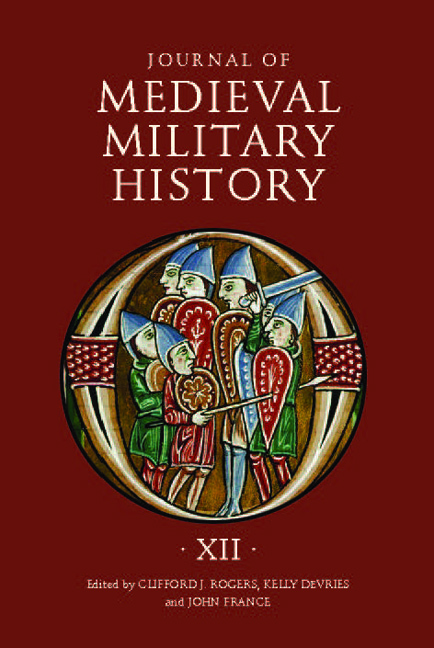Book contents
- Frontmatter
- Contents
- List of Illustrations and Map
- 1 Some Observations Regarding Barbarian Military Demography: Geiseric's Census of 429 and Its Implications
- 2 War Words and Battle Spears: The kesja and kesjulag in Old Norse Literature
- 3 The Political and Military Agency of Ecclesiastical Leaders in Anglo-Norman England: 1066–1154
- 4 Couched Lance and Mounted Shock Combat in the East: The Georgian Experience
- 5 The Battle of Arsur: A Short-Lived Victory
- 6 Prelude to Kephissos (1311): An Analysis of the Battle of Apros (1305)
- 7 Horse Restoration (Restaurum Equorum) in the Army of Henry of Grosmont, 1345: A Benefit of Military Service in the Hundred Years' War
- 8 The Indenture between Edward III and the Black Prince for the Prince's Expedition to Gascony, 10 July 1355
- 9 Investigating the Socio-Economic Origins of English Archers in the Second Half of the Fourteenth Century
- 10 War and the Great Schism: Military Factors Determining Allegiances in Iberai
- List of Contributors
- Journal of Medieval Military History 1477–545X
1 - Some Observations Regarding Barbarian Military Demography: Geiseric's Census of 429 and Its Implications
Published online by Cambridge University Press: 05 November 2014
- Frontmatter
- Contents
- List of Illustrations and Map
- 1 Some Observations Regarding Barbarian Military Demography: Geiseric's Census of 429 and Its Implications
- 2 War Words and Battle Spears: The kesja and kesjulag in Old Norse Literature
- 3 The Political and Military Agency of Ecclesiastical Leaders in Anglo-Norman England: 1066–1154
- 4 Couched Lance and Mounted Shock Combat in the East: The Georgian Experience
- 5 The Battle of Arsur: A Short-Lived Victory
- 6 Prelude to Kephissos (1311): An Analysis of the Battle of Apros (1305)
- 7 Horse Restoration (Restaurum Equorum) in the Army of Henry of Grosmont, 1345: A Benefit of Military Service in the Hundred Years' War
- 8 The Indenture between Edward III and the Black Prince for the Prince's Expedition to Gascony, 10 July 1355
- 9 Investigating the Socio-Economic Origins of English Archers in the Second Half of the Fourteenth Century
- 10 War and the Great Schism: Military Factors Determining Allegiances in Iberai
- List of Contributors
- Journal of Medieval Military History 1477–545X
Summary
Introduction
A dearth of sound quantitative information generally is recognized to be a serious problem faced by scholars who try to understand the history of the Late Antique West. In this context, demography surely is among those areas of study in which the substantial lack of statistically significant data is felt most keenly. As a result, estimates regarding population sizes in the Late Antique era remain highly controversial. The same may be said for the size of urban populations and for the urban districts (civitates) or rural administrative districts (pagi) of which, in each case, the fortified city (urbs) was the capital or administrative center. In light of the dearth of reliable statistical data, it is even rare to find a consensus in regard to whether a particular population was growing or declining over time, or, for that matter, whether it saw no significant change.
Perhaps the most controversial area of Late Antique demographic research or, at least, the most frequently debated focuses on the size of so-called “barbarian” groups, which in the past were often referred to as “tribes.” This is especially the case for those who moved from beyond the frontiers of the empire and settled within its borders. For example, there seems to be no general consensus as to the order of magnitude of the population of barbarians, as a whole, during the period from ca. 300 to ca. 500.
- Type
- Chapter
- Information
- Journal of Medieval Military HistoryVolume XII, pp. 1 - 38Publisher: Boydell & BrewerPrint publication year: 2014



